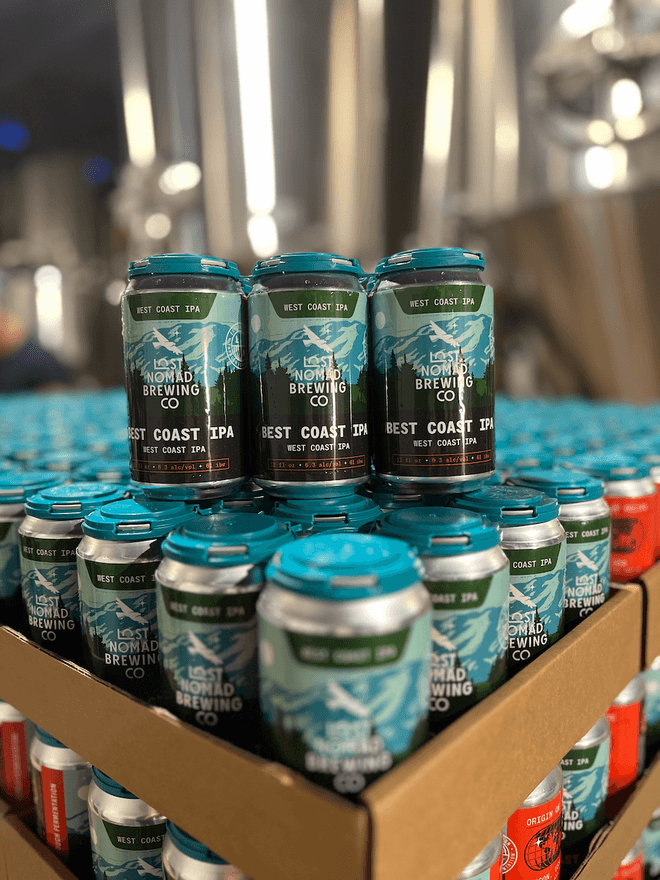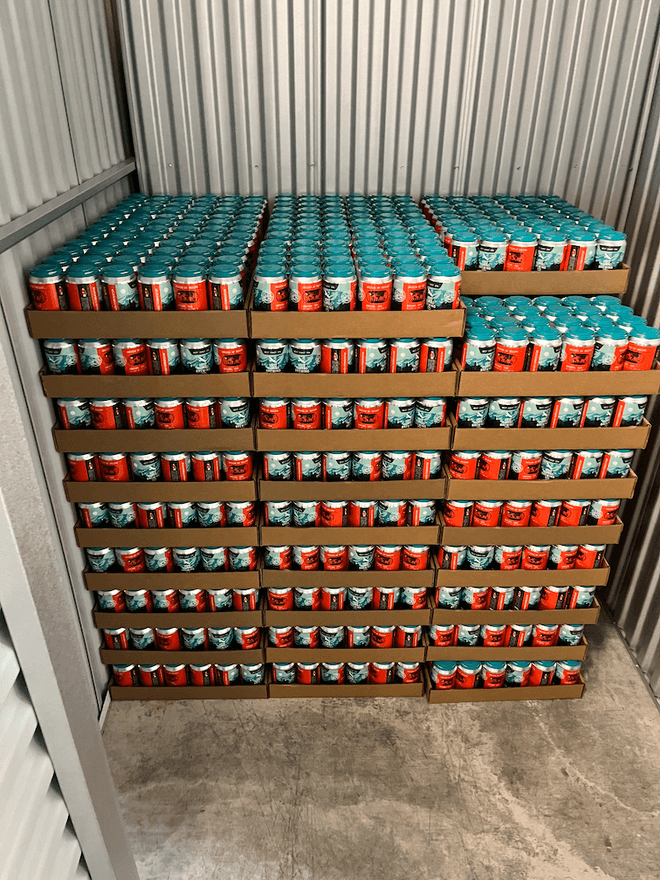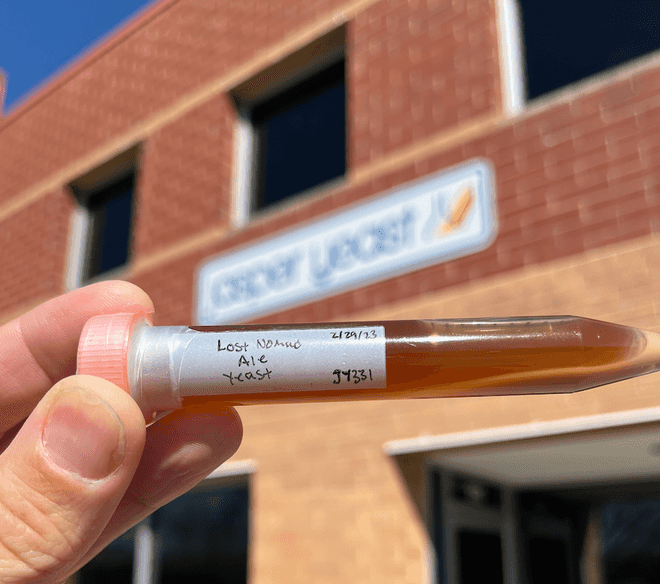Canned Beer in DC and Wrangled Yeast

Lost Nomad Brewing Company packed a lot into a ten-day trip back to the United States. Spread across Asheville, NC, and Washington, DC, the trip included a yeast workshop at White Labs, collection of our isolated West African wild yeast, and the kickoff canning run of our first batch of beer. What lands on the cutting room floor for this entry is all the legal and compliance paperwork. Ok, I’ll briefly mention it–and you can picture me filling this out in the early mornings and late evenings between the more interesting milestones in the journey of the brewery.
If you brew beer, particularly in the United States, you’re a factory janitor and a paralegal..then a struggling accountant, philosopher seeking solace, and an involuntary insomniac…then a brewer. Regardless, every brew and packaging day reminds you: this needs to exist.
I’ll Tarantino this post and start from the (more approachable) end of the trip.
Kickoff Production Canning
A couple of months ago I contracted with a brewery to produce 125 cases of my Best Coast West Coast IPA. This was a bit different take on the West Coast IPA than they had in their line up (which is, according to them, still a bit of a Hazy IPA) so it was mutually beneficial to give it a shot aside from the purely monetary side of things. So much so that we agreed to produce a bit extra and put it on tap in their tap room where we could both collect some market research. (Note: for the Local Nomads in DC, it’s currently on tap as of this writing).
Prior to canning day, I sent out notices for folks to join an event in the brewery tap room where they could pick up pre-purchased six packs and cases of beer. Without becoming a beer influencer on Instagram, I ended up with 81 cases of the original 125 to sell through self-and-local distribution in the DC and Virginia area. Oh, and we drained a keg the brewer put on tap for the event if that’s any upfront (albeit biased) market research. The brewery leadership and staff genuinely enjoyed the beer and I’m excited to hopefully inspire more West Coast IPAs in the area.
I like the blue topper almost as much as the beer itself
With 81 cases left, I’m now in sales and marketing mode. In the beer industry it’s a bit of a chicken or the egg with your very first beer (without a tap room): make a product that you can use to then get retail accounts and distribution agreements or discuss a thing that doesn’t exist in reality yet? I chose the former and I’m working to land around 30 accounts that I can distribute to and build up from.
Before you navigate the mountain of legal paperwork for distribution, where do you store beer? Naturally, I’m storing the beer in a storage unit across the street from the brewery and hand-delivering beer samples to leads (well, folks are helping me while I’m overseas). Also, anyone who wants beer can purchase via a Square link and drop by the storage unit to pick it up. At this early stage, we’re breaking our pencil underscoring the word scrappy.
Not ideal long term but allows us to keep moving forward
If You’re Brewing in the US, You Need a Lawyer
Ok well I have two lawyers. I mentioned before that I needed a lawyer early on for trademark work; now, it’s helpful to have a local one for state compliance if your existing one is less familiar with your area. The DC, Virginia, and Maryland area is an interesting place to brew: you’re so close to state lines that trademarking is dead simple since you can almost ship your beer across state lines by drone (if the drone wouldn’t be shot down by an F-16 for flying around the capitol region). However, working with any distributor means you’re immediately thrust into the compliance paperwork for multiple states. Yes, that’s as much fun as it sounds.
It was straightforward to become a licensed wholesaler in DC, meaning I can buy my contracted beer from the brewery and sell it to local retail in DC (and in DC you can also self-distribute). Distributing across the state District (too soon…) line requires, well, a laundry list of things you want a lawyer for. I still think I’m doing it wrong or that I’m going to miss some quarterly filing, but screw it. I’ve gotten pretty far with the idea to just keep moving–we’ll pay any fines if we missed something. In the long term, the learning is more important than the sum of the one-time fines.
Unless we missed a lot and a future blog post is written during the limited time I’m allowed with my fed-issued ankle bracelet on.
So at the moment I’m working on the compliance paperwork but it appears we’re close to being able to sign a distribution agreement with a hyper-local distributor who exists specifically because of the horror stories you hear elsewhere. Regardless, you can’t depend on a distributor to move your product; hence, I’m lining up accounts as fast as I can in the meantime.
Aside: Yeast Workshop
Part of this ten day trip back to the United States included a three-day workshop and lab by White Labs focused solely on yeast in brewery operations. It was a nice mix of folks from professional brewers and QA staff at mid-size breweries to early stage breweries or breweries in planning. Regardless of size, any brewery should have the tools they explained–a lot of which don’t require a lab or microscope. For me, I took away a few tools that can help me understand my system and debug when a problem arises:
- Using Whirl-Pak bags to take samples at different stages when transferring wort around the brewery. If the pack expands after a day or two, you have a problem with contamination (and you might not know it if you’re not packaging and distributing your beer). Very cheap way to identify “something” is now in your beer.
- Forced fermentation testing. Take a sample of wort from the fermenter and throw it on a stir plate with a decent pitch of yeast. This will tell you the absolute lower-bound of the final gravity you can expect from that wort. Helpful if you have a stalled or slow fermentation and want to determine if it’s your mash profile or a problem with the environment for the yeast in the primary tank. Of course I’ve never needed to do this…
I highly recommend the workshop and the lab to anyone who brews and can make it to a White Labs facility to take it. Or plan a trip to Asheville around it. If it’s for “school” your spouse is less likely to question the credit card expense.
Speaking of Yeast: Wild Yeast Results
In our last entry, we discussed taking an adult child to brew day and dropping off yeast from West Africa for analysis at a local yeast lab. In another life I think I would have worked in one of these labs in some capacity: a small group of people with a chemistry lab in front, brewery in back. A random guy walks in with an unmarked vial of (hopefully) yeast from West Africa and they take it in for analysis like it’s the 100th time this has happened.
The lab will do a series of tests to determine what strains are included in the sample and isolate each strain requested for future brews. They’ll also tell you the species and propagate up any strain you’d like to the proper pitch rate based on your beer batch size. Just as importantly, they’ll bank the yeast in their cryogenic freezer for future use…by your grandchildren.
We've got an officially banked yeast from West Africa!
In the end they isolated out a strain of Saccharomyces cerevisiae (specifically without the STA1 gene), which is a long way of saying it’s an ale yeast. They brewed a small batch with that isolated strain and came to the same conclusion I did in West Africa when I blindly brewed with it: it’s a neutral-tasting yeast with mid-to-low flocculation (the yeast tends to want to stay in suspension so you get a hazier beer).
So we’ll have to get creative with hops and fruits I think to make a beer that encapsulates the area where the yeast is from. It came from a Mini Mandarin Orange tree in our backyard, so some sort of citrus-focus for the beer makes sense to me.
What’s Next
Aside from playing with recipes for The (Redacted) West African Coast IPA, we’re primarily focused on distribution compliance in the DC and VA area. We’re also blowing up phones with sales calls to land some retail accounts to which we can then distribute across.
Mixed packs of beer have been in our plans since inception and it’s still a longer term goal once we’re steadily moving product. Until then we’re spreading awareness and giving folks a taste of the concept. There’s a bright future for using a nomadic brewery to generate and test recipes before they’re brought back to market in the US, and we’re excited to be as scrappy as we need to be to bring this concept to life.
Now excuse me while I go make some sales calls.
